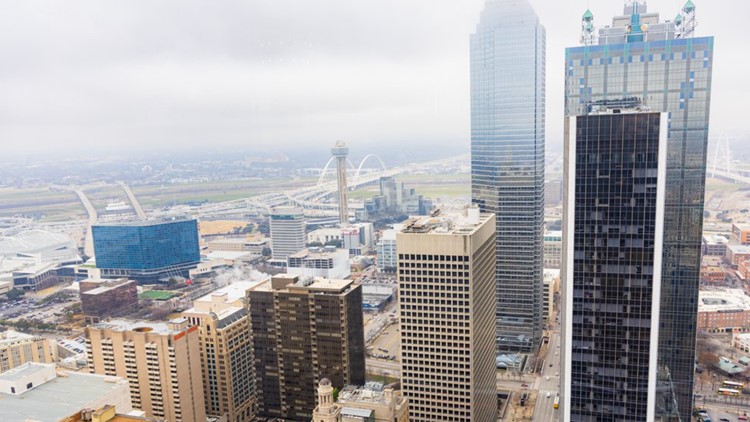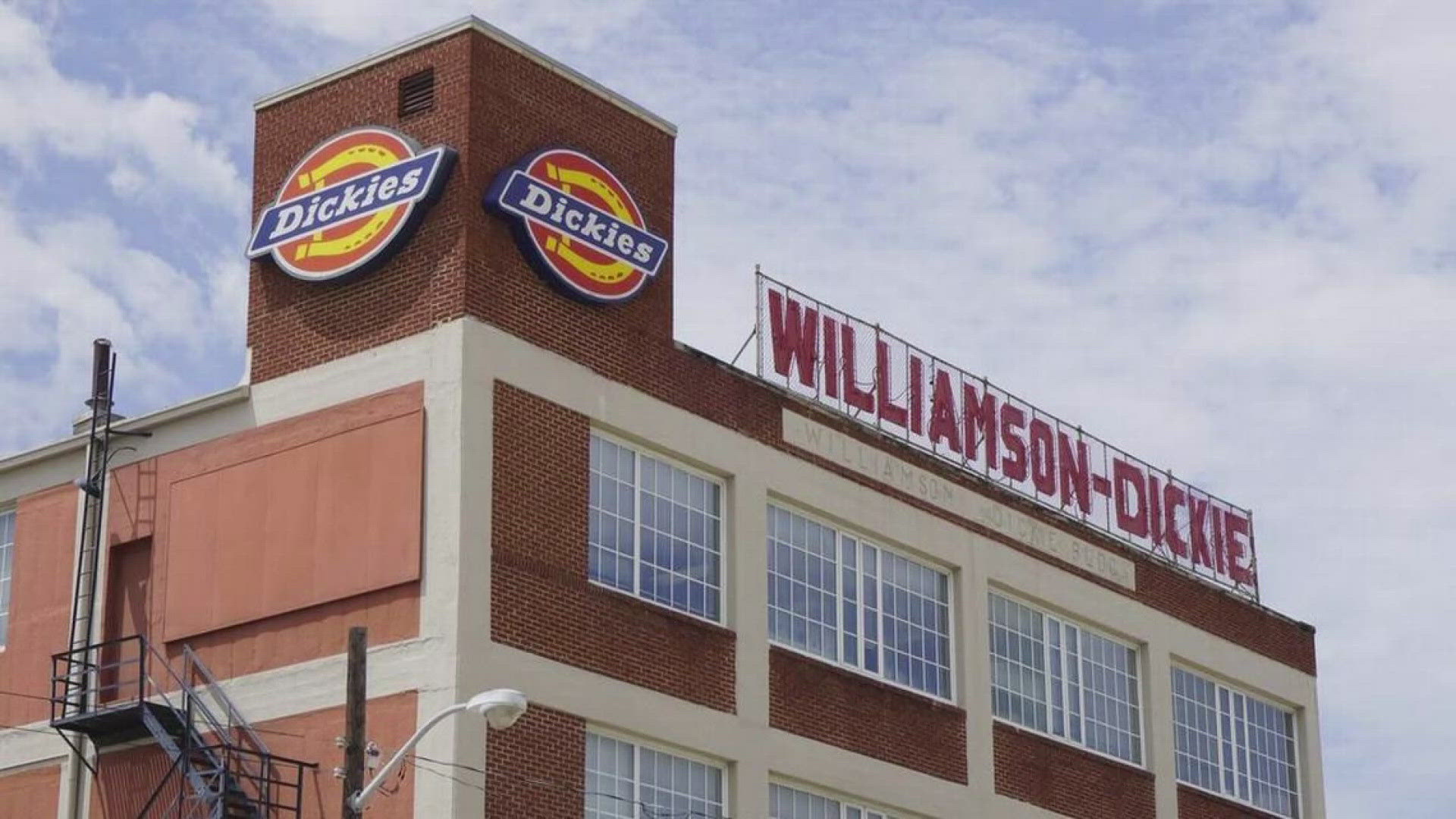DALLAS — Read this story and more North Texas business news from our partners at the Dallas Business Journal
Dallas ranks near the top of the pack when it comes to downtown recovery after the pandemic and No. 1 among the four biggest Texas cities.
That’s according to the latest Downtown Vitality Index from The Business Journals, which analyzed a variety of metrics affecting downtown activity to determine which central business districts are best positioned for success in the post-pandemic world.
Dallas posted a Downtown Vitality Index score of 58.41, which ranked No. 11 among the 44 markets analyzed by The Business Journals. The city was just ahead of Houston and trailing behind Greensboro and Raleigh, North Carolina. San Antonio and Austin were further down the list.
"When the pandemic hit in 2020, we were told it would take five years for tourism to recover," said Jennifer Scripps, president and CEO of Downtown Dallas Inc., the organization heading up support of economic development in the urban core. "It happened much faster than we had dared hope."
That score is based on a weighted formula that looked at these factors:
- Downtown office commercial real estate trends
- Urban/central business district hotel occupancy
- Percentage of individuals working from home
- Downtown cellphone activity compared to pre-pandemic levels
- Public-transit ridership trends
- Metro population growth momentum
The formula is weighted, with office space trends, work-from-home percentage and downtown cellphone activity among the heaviest factors. With the exception of downtown cellphone activity, the category scores are compiled using percentiles that show how downtowns around the nation compare. A score of 0 is worst and a score of 100 is best.
Those obviously aren't the only factors that contribute to downtown vitality, but this project aims to put downtown recoveries in context and spotlight standout performers in these metrics in conjunction with our recent Future of Cities event.
Miami topped this year’s Downtown Vitality Index, thanks to its strong momentum for office real estate, a thriving tourist economy and work-from-home rates that remain only slightly above the national average of 9%. Last year, another Florida city — Tampa — topped the list.
Here's a breakdown of each metric, the top performers in the category and key takeaways:
Downtown office commercial real estate
What we looked at: We analyzed central business district vacancy and absorption rates for office space from CoStar Group, Jones Lang LaSalle and Cushman and Wakefield.
Local picture: More than a fifth of downtown Dallas office space remains vacant, although the 21.6% vacancy rate at the end of 2023 was a slight improvement from 22.7% at the end of 2022. Absorption, which measures space leased minus space vacated, was also negative last year. Key buildings such as Trammell Crow Center, Chase Tower and Bank of America Plaza are soon to lose major tenants headed to Uptown, seeking newer space.
"There are a lot of trends that Dallas is experiencing like the nation, flight to new buildings that have come online and the contraction of existing leases," Scripps said. "That being said, we have talked to new tenants in downtown that have recently expanded their their footprint."
The takeaway: Several tech-centric metros that have struggled to backfill vacant spaces posted low scores in this metric, as have some cities that saw tremendous new construction of office space in the years leading up to the pandemic. Several fast-growing Sun Belt markets were among the standouts in the category.
Urban hotel occupancy
What we looked at: Using data from CoStar or local tourism associations, we tracked occupancy rates for hotels in central business districts or urban areas, and how those rates have rebounded since the onset of the Covid-19 pandemic.
Local picture: In 2023, Dallas urban hotel occupancy had recovered to about 93% of the level seen in 2019, according to CoStar, as also seen through huge demand improvements reported by S&P credit analysts at the downtown Sheraton hotel for a potential refinance loan. The future redevelopment of the Kay Bailey Hutchison Convention Center is expected to further boost the city's economic vibrancy. And big events such as April's solar eclipse bring massive crowds downtown, and the FIFA World Cup is expected to do the same.
"You feel it on the streets and it animates the city, having people walking around in the evenings or on weekends, whether they're business or leisure travelers," Scripps said.
The takeaway: While recovery was very strong in centers of commerce and tourism such as New York, Boston and Washington, D.C. — which all showed rates of at least 89% — some smaller regions such as Birmingham, Alabama, bounced back even stronger at 100% or more of their pre-pandemic level.
Local picture: In 2023, Dallas urban hotel occupancy had recovered to about 93% of the level seen in 2019, according to CoStar, as also seen through huge demand improvements reported by S&P credit analysts at the downtown Sheraton hotel for a potential refinance loan. The future redevelopment of the Kay Bailey Hutchison Convention Center is expected to further boost the city's economic vibrancy. And big events such as April's solar eclipse bring massive crowds downtown, and the FIFA World Cup is expected to do the same.
"You feel it on the streets and it animates the city, having people walking around in the evenings or on weekends, whether they're business or leisure travelers," Scripps said.
The takeaway: While recovery was very strong in centers of commerce and tourism such as New York, Boston and Washington, D.C. — which all showed rates of at least 89% — some smaller regions such as Birmingham, Alabama, bounced back even stronger at 100% or more of their pre-pandemic level.
But between those pockets, downtown has a lot of "gray zones," as Scripps says — it's not easy to walk between the convention center and other downtown attractions such as the Farmers Market, for example, or from the Discovery District to the West End. That's one problem downtown developers Headington Cos. and Pacific Elm Properties hope to solve by linking together the West End and the Arts District to each other and the rest of downtown with 30 acres of green spaces and towers along Field Street.
The takeaway: The latest data from the study, covering the spring of 2023, shows the average downtown is now at 74% of its pre-pandemic activity. Las Vegas, which is a unique case because of its focus on tourism, leads the nation at 103%. Among more traditional metro economies, top performers included San Jose, California; Miami; and Phoenix. At the other end of the spectrum, St. Louis, Minneapolis and Louisville, Kentucky, are all at 56% or less of their pre-pandemic activity level.
Remote work
What we looked at: The U.S. Census Bureau’s latest American Community Survey, which showed the percentage of workers in each metro who are working from home. For the purposes of the Downtown Vitality Index, a higher percentage of individuals working from home translates to a lower score in this metric, because high work-from-home percentages are a factor many communities say are limiting activity in their downtowns.
Local picture: Only 13.7% of people in Dallas worked from home in 2022, according to Census data. The Dallas area, not including Fort Worth, also ranked No. 1 in a Placer.ai report analyzing February foot traffic data for office properties across 11 major U.S. metro areas. This comes as reports say major financial institutions with large corporate presences in Dallas-Fort Worth have been strictly enforcing return-to-work mandates nationwide.
The takeaway: Not surprisingly, tech hubs like Silicon Valley, North Carolina's Research Triangle and Austin, Texas, generally had the highest percentage of individuals still working from home — with their averages hovering around 20%, which is well below the national average of 9%.
Public-transit ridership
What we looked at: This metric, based on data from the U.S. Department of Transportation, looked at public-transit ridership trends since 2019, as well as the one-year change from 2022 to 2023.
Local picture: Dallas Area Rapid Transit ridership is still down from pre-pandemic levels, but it rose by a double-digit percentage rate in 2023 compared with 2019. Work continues on the agency’s new Silver Line train, while DART CEO Nadine Lee has emphasized improving daily transit operations.
"I want to give it to DART with their new strategy," Scripps said. "They've really pivoted over the last couple of years to really focusing on security, safety and rider experience. It's paying off, and you're seeing it in these numbers."
The takeaway: Many transit systems have struggled since the pandemic, with the average system still down 29.6% compared to 2019. Metros with average levels of remote work and strong hotel occupancy rebounds also generally fared well in our public transit metric, as well as systems that have recently upgraded their systems.
Population growth
What we looked at: We analyzed the latest population growth estimates from the U.S. Census Bureau, taking into account growth since the pandemic and one-year growth between 2022 and 2023. While these are metro-level numbers and not limited to downtowns, they show which regions have the strongest momentum for population growth, which is a factor that adds vibrancy to downtowns.
Local picture: One category where DFW is a national leader is population growth, with an estimated 150,000-plus residents added across the Metroplex from mid-2022 to mid-2023 and a 5.7% change in population since 2020. But will huge numbers seen in the suburbs translate to robust business downtown? That remains to be seen.
The takeaway: The Sun Belt remains the star, dominating population metrics once again this year. Texas cities Austin, Dallas, Houston and San Antonio all showed three-year growth rates of at least 4.76%, with Orlando and Jacksonville in Florida hovering near 5% and 6.5%, respectively. A closer look at county-level data also shows some Midwest regions picking up the pace.
Expensive coastal metros like Los Angeles, New York and San Francisco continued to lag for population growth.
Editor-in-chief Will Anderson contributed reporting.
Other headlines:



